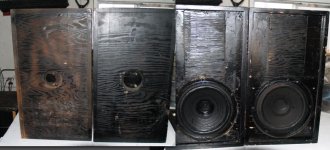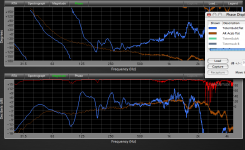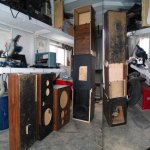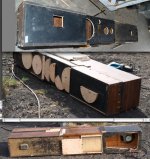My good fortune: nobody even bid the starting eBay price of $100 on my beat-up AR-1, Kloss and Vilchur design, earliest model, letter from Roy Alison, original manual, had it 45 years.
Even today, one of the great woofers of the universe... and I have been comparing it to my Klipschorn bass past few days (mixed bass, electronic crossover around 110 Hz).
So I've been thinking. If you had that particular 12 inch woofer with a strong-as-Masonite cone, reputed to have a 12 Hz free-air resonance (measures today about 39 Hz in the 1.2 cubic foot, "acoustic suspension," very very solid box), what would you do with it?
Please, no Karlson or tapped-horn designs. Almost for sure, needs a sealed box, eh. There seems to be no voice coil rubbing when mounted in any orientation.
Ummm, wouldn't it be yummy in a 3 cu ft box? Pity I have no access to those enclosure design programs, know the driver's T-S parameters, understand how to use them, let alone have much faith in their predictions (Patrick Bateman are you there?).
I'm crying at the prospect of cannibalizing a classic speaker but the market hath spoken. And where else can you find a 12 Hz woofer?
Thanks.
Ben
Footnote: yup, my ancient unused potted Partridge output transformer sold for a few nickels (OK... a few ten-thousand nickels).
Even today, one of the great woofers of the universe... and I have been comparing it to my Klipschorn bass past few days (mixed bass, electronic crossover around 110 Hz).
So I've been thinking. If you had that particular 12 inch woofer with a strong-as-Masonite cone, reputed to have a 12 Hz free-air resonance (measures today about 39 Hz in the 1.2 cubic foot, "acoustic suspension," very very solid box), what would you do with it?
Please, no Karlson or tapped-horn designs. Almost for sure, needs a sealed box, eh. There seems to be no voice coil rubbing when mounted in any orientation.
Ummm, wouldn't it be yummy in a 3 cu ft box? Pity I have no access to those enclosure design programs, know the driver's T-S parameters, understand how to use them, let alone have much faith in their predictions (Patrick Bateman are you there?).
I'm crying at the prospect of cannibalizing a classic speaker but the market hath spoken. And where else can you find a 12 Hz woofer?
Thanks.
Ben
Footnote: yup, my ancient unused potted Partridge output transformer sold for a few nickels (OK... a few ten-thousand nickels).
Last edited:
Well, the pioneers of audio claimed that the optimum vented alignment was one tuned to Fs and the cab's Vb whatever it was in a sealed cab that raised its Fs 1.56x, so since you have no faith in T/S et al, do it their way and you get most of the ~sealed alignment's perks with an extra half octave of gain BW.
GM
GM
Sorry if I seemed to be dismissing T-S. I have no doubt their analysis gives correct answers in engineering terms. It is just might not be as satisfactory in perceptual terms and hence might not deserve the uncritical adherence it gets in some places.
Indeed, the "pioneer" rules of thumb were an effort to create satisfactory perceptual experience in the absence of anything better than Olsen's textbook. For example, tuned boxes were shifted slightly off from the driver resonance (I forget which way but maybe up to give more oomph to the upper boom).
Indeed, the "pioneer" rules of thumb were an effort to create satisfactory perceptual experience in the absence of anything better than Olsen's textbook. For example, tuned boxes were shifted slightly off from the driver resonance (I forget which way but maybe up to give more oomph to the upper boom).
Ben,My good fortune: nobody even bid the starting eBay price of $100 on my beat-up AR-1, Kloss and Vilchur design, earliest model, letter from Roy Alison, original manual, had it 45 years.
Even today, one of the great woofers of the universe... and I have been comparing it to my Klipschorn bass past few days (mixed bass, electronic crossover around 110 Hz).
So I've been thinking. If you had that particular 12 inch woofer with a strong-as-Masonite cone, reputed to have a 12 Hz free-air resonance (measures today about 39 Hz in the 1.2 cubic foot, "acoustic suspension," very very solid box), what would you do with it?
Please, no Karlson or tapped-horn designs. Almost for sure, needs a sealed box, eh. There seems to be no voice coil rubbing when mounted in any orientation.
Ummm, wouldn't it be yummy in a 3 cu ft box? Pity I have no access to those enclosure design programs, know the driver's T-S parameters, understand how to use them, let alone have much faith in their predictions (Patrick Bateman are you there?).
I'm crying at the prospect of cannibalizing a classic speaker but the market hath spoken. And where else can you find a 12 Hz woofer?
Thanks.
Ben
I also have a pair of what may be AR-1 (prototypes ?) I found on the side of the road, all components working.
I may use the cones for tapped horns. Sorry, not what you want but a TH should give a six dB sensitivity advantage and may extend the FR down to the FS. A larger ported cabinet could also
From the web research I have done so far, found one reference saying the AR-1 bass cone FS is around 14-18 Hz.
The cones are the cloth surround with an deep Alnico magnet, I was amazed to find they are older than me!
The HF is a pair of 5" cones with felt dust caps in a "V" configuration, made of plastic with back chambers for the two cones.
I was looking for T.S. parameters for the woofer yesterday, but found none, and also found no reference to the 5" cones as tweeters.
Do you remember any AR- configurations using 5" cones for HF ?
Anybody know the TS parameters for the old AR-1 12" ?
Art
Weltersys -
Take care, you may have something interesting there. Check these:
1. instead of two binding posts, has a whole bunch on back?
2. are those the famous Altec "Pancake" speakers that had a compliance ring about half-way out from the dust cap so that the cone could kind of change size depending on the frequency? It is very shallow. I say "famous" because it derives from the Bell Labs (West Street) lineage like a lot of Altec units.
The oldest ones had a smooth-surface woofer cone made from heavy and very very stiff cardboard with an accordion surround. I thought the resonance was around 12 Hz in free air but they may have varied over the years.
Later on, AR became committed to dome mid-range and tweeters in the AR-2 and -3 and -3a and these were pretty great speakers.
Take care, you may have something interesting there. Check these:
1. instead of two binding posts, has a whole bunch on back?
2. are those the famous Altec "Pancake" speakers that had a compliance ring about half-way out from the dust cap so that the cone could kind of change size depending on the frequency? It is very shallow. I say "famous" because it derives from the Bell Labs (West Street) lineage like a lot of Altec units.
The oldest ones had a smooth-surface woofer cone made from heavy and very very stiff cardboard with an accordion surround. I thought the resonance was around 12 Hz in free air but they may have varied over the years.
Later on, AR became committed to dome mid-range and tweeters in the AR-2 and -3 and -3a and these were pretty great speakers.
Last edited:
I think there may have been a full range input, and separate binding posts for the woofer and tweeter originally, (four or six separate binding posts) but I removed the crossover, tweeter pack and the extra binding posts after finding the "tweeters" rolled off around 10K.Weltersys -
Take care, you may have something interesting there. Check these:
1. instead of two binding posts, has a whole bunch on back?
2. are those the famous Altec "Pancake" speakers that had a compliance ring about half-way out from the dust cap so that the cone could kind of change size depending on the frequency? It is very shallow. I say "famous" because it derives from the Bell Labs (West Street) lineage like a lot of Altec units.
The oldest ones had a smooth-surface woofer cone made from heavy and very very stiff cardboard with an accordion surround. I thought the resonance was around 12 Hz in free air but they may have varied over the years.
The woofer has just a half round cloth surround, and a felt dust cover IIRC.
I don't recall it being super stiff material, just "normal" pulp cardboard.
They later went to a foam surround (probably 99 % of those rotted out) and ceramic magnets, so these are probably mid 1950s.
Art
I really can't claim good knowledge, but the previous comments are my picture of the oldest ARs, till an expert replies. Cones is smooth, not really pulpy. Don't know about the half-round surround - the old ones are rather plain impregnated cloth with corrugations, as in olden days.
Could these have been re-coned?
Could these have been re-coned?
Ben,I really can't claim good knowledge, but the previous comments are my picture of the oldest ARs, till an expert replies. Cones is smooth, not really pulpy. Don't know about the half-round surround - the old ones are rather plain impregnated cloth with corrugations, as in olden days.
Could these have been re-coned?
After some more research, it appears my speakers may be a prototype of the AR-2a, which was available from 1960-69.
I have no idea why a late 1950's prototype from Boston ended up discarded on the side of Hiway 14 in Madrid, New Mexico.
The AR-2a was a three way using the same cones with a (much needed) tweeter.
The AR-2a woofer was nominally listed as a 10”, though the diameter is 11 1/8th, and the cone diameter inside the surround only 7.5”.
It appears to be original, though what was a foam or felt ring is gone, just some glue or foam residue remaining. I painted over the cone, it looked like the AR-2a prior to the paint.
I’ll try to Frankenstein some unused cabinets into a tapped horn today and post the before and after frequency response of the cabinets.
The speakers have about 17% second harmonic distortion with only 15 V at 40 Hz, so I'm not expecting "big" results...
Attachments
Thanks for info. I was trying to remember what an AR-2 looked like last night.
Testing at "15 V" sounds like a pretty big input, with the other gremlins in the testing chain on top of that.
Even today, I'd put an AR-1 or AR-3 (with a resonance around 38-40) among the greatest sounding woofers as far as making impressive bass in home music rooms goes. AR-2 was a junior size, if I recall. Cosmically LF output is a treat but on so few music recordings, hardly worth fussing over if it means other compromises (which it does).
Testing at "15 V" sounds like a pretty big input, with the other gremlins in the testing chain on top of that.
Even today, I'd put an AR-1 or AR-3 (with a resonance around 38-40) among the greatest sounding woofers as far as making impressive bass in home music rooms goes. AR-2 was a junior size, if I recall. Cosmically LF output is a treat but on so few music recordings, hardly worth fussing over if it means other compromises (which it does).
15V is only about 28 watts, not very big in SPL level (with this speaker about 100 dB at one meter) or power.Thanks for info. I was trying to remember what an AR-2 looked like last night.
Testing at "15 V" sounds like a pretty big input, with the other gremlins in the testing chain on top of that.
Even today, I'd put an AR-1 or AR-3 (with a resonance around 38-40) among the greatest sounding woofers as far as making impressive bass in home music rooms goes. AR-2 was a junior size, if I recall. Cosmically LF output is a treat but on so few music recordings, hardly worth fussing over if it means other compromises (which it does).
The AR-2 and AR-2A (and whatever my speakers actually are) are 24 x 11.5 x 13.5, still fairly large by today's standards, but small compared to anything in the 1950's that had 40 Hz response.
Last edited:
The experiment was somewhat successful, a gain of 8.2 dB at 40 Hz and 5.9 dB at 31 Hz was achieved with no expense other than time and the cost of screws and caulk.I’ll try to Frankenstein some unused cabinets into a tapped horn today and post the before and after frequency response of the cabinets.
A total of seven cabinets and lots of speaker cutouts were grafted together.
The TotemPoleSub cabinet stands 80" tall, the path length about double that.
Frequency response is pretty ragged in the tapped horn, but may actually compliment the other subs I am using below the eight 2 x5" (& 6") + tweeter shop speakers.
The charts are from outdoor measurements at two meters. "0 dB" is equivalent to about 87 dB one watt one meter.
Art
Attachments
Last edited:
Thanks !Looks to me like a true piece of Art 🙂
It does make me feel better to use the cabinets for speakers rather than planters, which was what I had been keeping them for.
Particle board makes for lousy planters though.
The AR speaker cabinet sides were actually veneered pieced pine lumber, never saw that in a speaker cabinet before.
I will have to do some listening and see if it is worth the price of lumber to make a second cabinet, looks like it takes about two 4x8 sheets. Maybe I'll just cut a second hole and make this a push pull TH...
Few boxes as solid as the old AR cabinets. Hurts your knuckles to rap on them.
You have valuable information: using the impedance curve or just a finger, can you say what the free air resonance is, what the big-box resonance is, and how big would you guess the big box to be? Also, do those super low resonance cones start to wobble and rub and bump without the restoring force they previously got in the small AR box?
I've been puzzling for some time about what kind of results you'd get with a SUPER low resonance woofer (like the AR-1, etc.) but put into a bigger box. Why can't you buy such drivers?
You have valuable information: using the impedance curve or just a finger, can you say what the free air resonance is, what the big-box resonance is, and how big would you guess the big box to be? Also, do those super low resonance cones start to wobble and rub and bump without the restoring force they previously got in the small AR box?
I've been puzzling for some time about what kind of results you'd get with a SUPER low resonance woofer (like the AR-1, etc.) but put into a bigger box. Why can't you buy such drivers?
There are still lots of drivers with very low FS, mostly car subs. Look up DSL's Matterhorn, that uses (lots of) car subs with very low FS.Few boxes as solid as the old AR cabinets. Hurts your knuckles to rap on them.
You have valuable information: using the impedance curve or just a finger, can you say what the free air resonance is, what the big-box resonance is, and how big would you guess the big box to be? Also, do those super low resonance cones start to wobble and rub and bump without the restoring force they previously got in the small AR box?
I've been puzzling for some time about what kind of results you'd get with a SUPER low resonance woofer (like the AR-1, etc.) but put into a bigger box. Why can't you buy such drivers?
The big box interior dimensions are 15.5" deep at the top, 14" deep at the bottom, 11.5 wide, 78.5" tall, about 7.7 cubic feet, the original cabinet about 1.56 cubes.
I'll be testing the excursion at various frequencies in both boxes which will tell the Fb. I expect the TotemPole Sub could use a 25 Hz or so HP, one of the tinsel leads broke while I was using full range pink noise.
It was a kind of slow failure, made testing difficult as the cone would be intermittent, then could be "push started", which would cause it to motorboat on and off, finally the solder cracked and the problem became apparent. However, push starting the cone had caused a fault which put the amp into protect, which caused more delays while I figured that out...
I did not look at the cone while testing before the tinsel lead broke, but after, with a 25Hz BW 24 HP it seemed about the same excursion as the sealed box cone.
Art
Last edited:
Thanks for reference.
Video of Matterhorn
I didn't see a write-up about the speaker, just the video linked above.
The design (and design compromises) for each kind of setting - car, home, stadium, or shipping containter - lead to drivers not too suitable for other settings.
Video of Matterhorn
I didn't see a write-up about the speaker, just the video linked above.
The design (and design compromises) for each kind of setting - car, home, stadium, or shipping containter - lead to drivers not too suitable for other settings.
You have valuable information: using the impedance curve or just a finger, can you say what the free air resonance is, what the big-box resonance is, and how big would you guess the big box to be? Also, do those super low resonance cones start to wobble and rub and bump without the restoring force they previously got in the small AR box?
?
The big TotemPoleSub significantly reduces excursion other than below 22 Hz or so.
I did not use swept tones to find the exact Fb, it would be somewhere in the 25-35 Hz range. This alignment seems to be specific as to “Fb” than the two other TH I have built, and most sims I have seen.
The extra LF of the Totem was easily heard and felt, as well as various shop stuff rattling. Unfortunately had an equipment malfunction, so can't post distortion figures for the Totem, but it seemed clean at the 10.9 drive level.
Tests with 10.9 V sine wave yielded about 10% distortion at 45 Hz in the sealed AR-2? cabinet.
Peak to peak excursion for the AR-2? at 10.9 V was:
20 Hz 8, 25 Hz 8, 30 Hz 9, 35 Hz 10, 40 Hz 12, 45 Hz 12.5, 50 Hz 12, 60 Hz 9.
Seems the air cushion limits excursion (and frequency response) below 40 Hz.
Peak to peak excursion for the AR-2? loaded Totem TH Sub at 10.9 V was:
20 Hz 9, 25 Hz 5, 30 Hz 5, 35 Hz 5, 40 Hz 9, 45 Hz 9, 50 Hz 5, 60 Hz <1.
I took RTA shots of the both speaker, unfortunately the Totem shots had technical problems (mic unplugged or something) so will re test at a later date.
Art
Um, I thought the AR-1, etc. was 4 ohms. Which means double the power... that's a lot. What is the coil resistance - that should tell?
Sorry if I seemed to be dismissing T-S. I have no doubt their analysis gives correct answers in engineering terms. It is just might not be as satisfactory in perceptual terms and hence might not deserve the uncritical adherence it gets in some places.
Nothing wrong with Thiele-Small: it only describes how a vented box works as a tuned circuit.
The sample alignments in the original paper might be questioned, however, especially the sixth-order ones, not because they don't work, but because they don't give proper answers in the listening context.
1) Most rooms show a gain increase at low frequencies due to boundary effects. Summing the gain delta from the three nearest walls shows a curve rising between 6 dB/octave and 12 dB/octave (because as the contribution from the nearest surface is close to done the furthest wall begins to have an influence). That's why many people like sealed-box mini-monitors: because contrary to most expectations they can actually have close to flat frequency response in average-sized rooms, whereas Butterworth-tuned vented boxes will show an increase in bass until cutoff, when the bass goes away in half an octave.
2) Group delay increases with alignment order. Experiments showed me phase response is audible, not so much at higher frequencies as most people suspected, but more in the midbass to low frequencies (midbass phase rotation is most obvious on percussion such as snare drums, manifested as a more polite, less immediate instrument). Higher order alignments will show larger group delay at cutoff, with noticeable effects at least an octave away in the passband.
One can use the Thiele-Small equations and a bit of math to come up with equations showing response at Fb lower than the -3 dB of the usual Butterworth alignments (gain @ Fb = -5 dB or -6 dB is a good place to start, corresponding to Vas / Vab of 1.8 to 2.0 respectively), although anything greater than 4th order should be avoided. These mitigate the above problems to a great degree while keeping vented box virtues such as FR extension and reduced distortion. LF rolloff starts a bit earlier and more gradually, which works better with the usual room gains, whereas the reduced Q means group delay doesn't change as abruptly as it would for sharper alignments.
- Status
- Not open for further replies.
- Home
- Loudspeakers
- Subwoofers
- AR-1 woofer - new enclosure?




